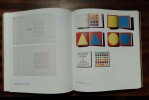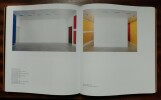[LEWITT Sol] COLLECTIF
Sol LeWitt
Metz, Editions du Centre Pompidou-Metz, 2012, 25,5 x 28,5, 326 pages sous cartonnage éditeur imprimé. Iconographie noir & blanc et couleurs. Ouvrage publié à l'occasion des expositions présentées à Louvain du 21 juin au 14 octobre 2012 et au Centre Pompidou-Metz du 7 mars au 29 juillet 2013.
Reference : ARTTTTT91910924
ISBN : 9782359830187
Très bon état.
Bookseller's contact details
Le Plaisir du Texte
M. Fabrice Sivignon
1 rue Violi
69001 Lyon
France
04 78 58 44 04
Payment mode
Sale conditions
Règlement par chèque, mandat, virement bancaire ou Paypal. Prix en euros, auxquels il convient d'ajouter le coût du port. Les livres voyagent aux frais et risques de l'acheteur. Expédition dès réception du règlement.
5 book(s) with the same title
Sol Lewitt. Working drawings
New York - Chicago John Weber Gallery - Rhona Hoffman Gallery 1995 In-4 à l'italienne Broché, couverture illustrée
Catalogue de cette exposition organisée du 25 mars au 22 avril à New York, puis du 28 avril au 9 juin à Chicago. 32 reproductions en noir de dessins de Sol Lewitt, l'un en couverture. 28 pp. >Bel exemplaire Très bon 0
Strict Beauty - Sol Lewitt Prints
Couverture rigide New Haven, Yale University Press, 2020. Un volume petit in-4 (26 x 22,5 cm), cartonnage d'éditeur illustré, sous son blister d'origine. 288 pages, illustrées de 416 reproductions en couleurs et 6 en noir et blanc. Texte en anglais. L'artiste conceptuel Sol LeWitt (1928-2007) est surtout connu pour ses dessins muraux et ses structures modulaires. Parallèlement à ces œuvres, il a réalisé plus de 350 projets d'impression, comprenant des milliers de lithographies, de sérigraphies, d'eaux-fortes, d'aquatintes, de gravures sur bois et de linogravures. Cet ouvrage généreusement illustré est le premier à présenter de manière exhaustive la pratique de l'estampe de LeWitt, importante mais encore peu explorée. Avec plus de 400 illustrations, dont beaucoup n'ont jamais été publiées auparavant, cette étude offre une image plus complète de l'œuvre de LeWitt et situe les gravures de LeWitt dans le contexte plus large de son approche sérielle, systémique et basée sur des règles de la création artistique. Bel exemplaire, comme neuf.
Comme neuf
Chroniques de l'Art Vivant - Aimé Maeght et Jean Clair - Irmeline Lebeer - Harald Szeemann - Madeleine Deschamps - Catherine Millet et Terry Atkinson - Sol LeWitt - Paul Lebeer - Michel Vachey sur Abraham Moles - M. Mattys - Eusebio Sempere - Henry Galy-Carles sur John Withney - Gérald Gassiot-Talabot sur Gilles Aillaud - Bernard Dufour - Alvaro Manuel Machado sur Carlos Fuentes - Vladimir Forgeney - Daniel Caux et Terry Riley - Yves Navarre - Miro
Reference : CAV-25
(1971)
Chroniques de l'Art Vivant n° 25 - Novembre 1971 - Cassel Documenta 5, - Houston De Luxe Show - Bruxelles, le dessin contemporain - Art-Language à Londres, et Terry Atkinson - Sol LeWitt - Abraham Moles - Esthétique numérique, concepts de base- Madrid, Centre de calcul - Eusebio Sempere - John Withney, Ordinateur et création animée - Gilles Aillaud - Bernard Dufour - Carlos Fuentes et l'impossible fête - Vladimir Forgeney - The Mood of Terry Riley - Amsterdam, 2nd Wet Dream Film Festival - Miro sur le vif
Maeght Editeur - Chroniques de l'Art Vivant Ferce sur Sarthe, France 1971 Book Condition, Etat : Bon broché, sous couverture imprimée éditeur, illustrée d'un guerrier chinois avec une femme nue grand In-4 1 vol. - 32 pages
très nombreuses illustrations en noir et blanc 1ere édition Contents, Chapitres : Irmeline Lebeer : Cassel Documenta 5, entretien avec Harald Szeemann, 4 pages avec 16 illustrations - Madeleine Deschamps : Houston De Luxe Show - Bruxelles, le dessin contemporain (Galerie Withofs) - Catherine Millet : Art-Language à Londres, entretien avec Terry Atkinson, 1 double-page - Irmeline Lebeer : Sol LeWitt - Textes inédits en français - Paul Lebeer : LeWitt l'inventeur - Michel Vachey : Entre la science et le kitsch, Abraham Moles - M. Mattys : Esthétique numérique, concepts de base- Madrid, Centre de calcul - Eusebio Sempere - Henry Galy-Carles : John Withney, Ordinateur et création animée - Gérald Gassiot-Talabot sur Gilles Aillaud - Jean Clair : Entretien avec Bernard Dufour, 1 double page illustrée - Alvaro Manuel Machado : Carlos Fuentes et l'impossible fête - Le feu sacré de Vladimir Forgeney - Daniel Caux : The Mood of Terry Riley, entretien - Yves Navarre : Amsterdam, 2nd Wet Dream Film Festival - Miro sur le vif en 4eme de couverture
POINSOT (cord.) / BOLTANSKI Christian, BUREN Daniel, Gilbert & Georges, KOUNELLIS JANNIS, Sol LEWITT, Richard LONG, Mario MERZ.
Reference : 17380
COLLECTION. BOLTANSKI Christian, BUREN Daniel, Gilbert & Georges, KOUNELLIS JANNIS, Sol LEWITT, Richard LONG, Mario MERZ.
Bordeaux, CAPC Musée d'art contemporain, 1990, in-4 cartonné sous jaquette, 209 pp, nombreuses illustrations dont dépliantes, catalogue d'exposition. Collection Christian Boltanski, Daniel Buren, Gilbert & George, Jannis Kounellis, Sol LeWitt, Richard Long, Mario Merz. TRES BON ETAT
Sol LeWitt: Six geometric figures and all their double combinations
Sol LeWitt: Six geometric figures and all their double combinations. Exhibition: Paris, Yvon Lambert, 1980. 15 black and white plates. Paperback. 21.5 x 16cms.
 Write to the booksellers
Write to the booksellers




